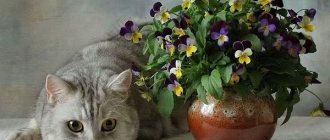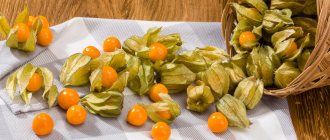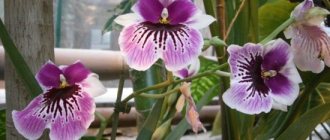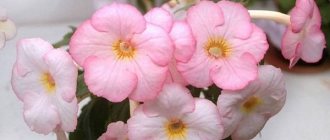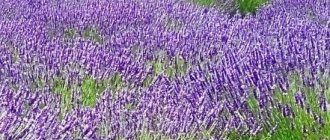general information
Pansies came to us from Europe, and spread throughout the globe from Asia to the Western part of our continent. Viola belongs to the violet family. These plants have a rod shape, and their stem reaches a height of up to 35 cm. Viola buds are usually single.
In the wild, flowers grow like weeds and do not add any aesthetics or beauty to the place where they grow.
Surprisingly, some species of these plants are able to bloom even in cold climates.
9. Diseases and pests
Chlorosis occurs when planting in alkaline soil with a high lime content. Botrytis. Powdery and downy mildew due to prolonged exposure to a cool and too humid atmosphere. Root rot occurs when there is insufficient drainage in pots or excessive watering and stagnation of moisture at the roots. Gray rot and black leg can appear with high air humidity and insufficient air movement. If there is a lack of nutrition, the buds will become small and less brightly colored - they will remain pale. Rust.
Viral spots - infected plants cannot be treated; they are destroyed.
Harmful insects may include aphids, spider mites, root-knot nematodes, various caterpillars, snails and slugs. Thrips can quickly destroy young plants.
↑ Up,
Description and features
Pansies are called tricolor viola, popularly Ivan da Marya. They belong to the violet family. Plants exist as annuals, biennials and perennials.
Flowers are divided into spring and summer blooming. This is probably their uniqueness: any variety is suitable for choosing the flowering time.
It all depends on the landing time. The root is a brownish rod in the form of a rod with small branches. The stem extends from 10 to 30 cm. The inside is hollow, triangular, erect or branched. Single buds with five petals sit on triangular peduncles with two bracts near the flower.
Flower petals differ in size. Two of them are larger than the others. The color of the petals has a different range of shades, even black. There are spots in the center of the bud, and a picture emerges, like a muzzle.
The poetic name of the pansy has given rise to many legends. Many countries and even regions have their own answers about why pansies are called:
According to an ancient legend, the flower got its name in honor of the girl Anyuta, who could not stand the separation and injustice towards herself and died.
And it all started like in a fairy tale, the guy fell in love with the girl, she reciprocated. The seducer simply disappeared forever.
After her death, flowers with different colors stretched out on the grave, as if betraying her feelings: hope, resentment, sadness.
The Romans say that men spying on the goddess of love were turned into flowers with eyes.
In Russia, according to legend, a girl and a guy loved each other. Their parents separated them and married the guy to a rich girl. Anya died of melancholy.
Another legend, a girl, not getting a guy, died of melancholy. Flowers grew on the edge of the road, as if they continued to wait for their loved one.
11.Interesting facts, legends and signs
In Rus' there was a belief that if you pick a few viola buds, it will start raining. The flower is depicted on the coat of arms of Izhora, a small town in Karelia.
There is a legend according to which a certain girl, Anna, loved a young man, but his relatives found another bride for the guy. During the wedding of the newlyweds, Anyuta died, and at the site of her death a beautiful flower grew.
According to another version, Anna was waiting for her beloved from the war, cried all her eyes, looking at the road and after her death became a bright flower.
With the help of pansies they even bewitched loved ones - the juice of the plant was sprinkled on a sleeping person, who, immediately after waking up, fell madly in love with the first person he met.
↑ Up,
Currently, breeders have developed more than 200 varieties, differing in the size and color of the buds, and the height of the bushes. Modern plants can have simple and double flowers, the edges of the petals may be corrugated.
Plants also differ in the time of flowering, resistance to frost, other adverse factors and diseases.
It is believed that small-flowered plants will be the hardiest, while large-flowered plants need careful care and protection from negative factors.
Characteristics of species
All varieties of violas are conventionally divided into two main groups, since the remaining species are approximately between them.
- First group: with large flowers (diameter 10 cm)
- Second group: with small flowers (diameter no more than 6 cm)
Small-flowered
Large-flowered
Most gardeners are of the opinion that the larger the size of the flower itself, the better. But this is an erroneous judgment.
As practice shows, plants with small flowers turn out to be much hardier than their fellow species.
Small-flowered crops are more adapted for cultivation in the most unpleasant climatic and weather conditions, as they easily tolerate temperature changes, as well as sudden changes in conditions when rainfall suddenly turns into heat and drought.
Also, in defense of small-flowered violets, I would like to note that a dense carpet of such flowers turns out to be even more colorful and bright than when plants with large flowers are planted.
Despite the fact that violas with small flowers have become very popular in the north, gardeners from the southern regions have become very fond of them.
It is worth noting that in hot climates, pansy flowers begin to gradually decrease in size. As a result, by the end of the southern season they become even smaller.
For this reason, small-flowered violas in the south are grown mainly on balconies, and larger varieties are planted in flower beds.
Division by size:
- short;
- medium height;
- tall.
Tall Short
depending on the edge of the petals:
- with even petals;
- with a wavy edge.
Smooth petals
Wavy petals
The color palette distinguishes:
- with monochrome coloring;
- two-color;
- with contour blots and stripes.
12. Varieties and types:
12.1. Double pansies
A distinctive feature of varieties with double flowers is the presence of a large number of petals in each bud.
↑ Up,
12.2.Pansy Rococo
Terry plants with large and brightly colored flowers. The tips of the petals of plants of this variety are highly corrugated. The bushes are compact in size and do not exceed 20 cm; the flowering period lasts from April until serious frosts.
↑ Up,
12.3.Pansies Flamenco
Terry corrugated buds of plants of this variety reach a diameter of 5 - 7 cm, bushes grow up to 23 cm. This variety has good resistance to frost.
↑ Up,
12.4.Pansies Reinhold
During the flowering period, the bushes form simply gigantic flowers, the diameter of which reaches 8 cm. The height of the plants is 15 - 20 cm, they are frost-resistant and bloom very profusely.
↑ Up,
12.5.Pansy Ullswater
The dark, rich flowers of this variety are painted in blue or purple tones with dark spots in the center of the buds. The bushes are very compact - their height does not exceed 15 cm, the buds reach a diameter of 5 - 7 cm.
↑ Up,
12.6.Pansies Bergvasht
The variety is a giant with very large flowers up to 8 cm in diameter with deep purple petals and a bright golden-orange center. The bushes reach only 15 cm in height.
↑ Up,
12.7.Pansies Malvina
The variety is compact - no more than 15 cm in height with bright buds painted in several shades. The flower petals are bluish-blue, with a white center and a dark, almost black center.
↑ Up,
12.8. Pansy Silverbride
A distinctive feature of this variety are white flowers with dark purple spots on the petals.
↑ Up,
Types of pansies
The pansy flower has several varieties. All of them differ from each other in color and type of inflorescences. Also, their habitat is different, since each species is adapted to certain conditions. Let's look at the most common types of pansies.
Viola tricolor
So named because of the tricolor color of the flowers. Mostly there are combinations of white, yellow and purple colors. Grown as an outdoor plant, it is a bush 20 cm high. The flowering time of the tricolor viola is in April. By the end of the season, the bush falls off and thins out. This species lives no more than two years. It can be used for medicinal purposes, such as making a decoction of the leaves.
Viola yellow
This is a very miniature flower, since on average it grows 10-12 cm in height. The inflorescences are yellow and large in diameter, reaching about 5 cm. The uniqueness of this species is that it is able to withstand severe frosts, down to 30 degrees Celsius below zero . Yellow viola actively blooms in May and blooms for 2-3 months. In Russia, this type is rarely bred at home, since it requires very careful care.
Fragrant violet
The most common type of pansy. It grows longer than other varieties and reaches a height of 14-15 cm. The flower is unpretentious in care, but does not tolerate frost, so it can exist well all year round only at home. The inflorescences are small, but at the same time they emit a very bright and pleasant aroma. The fragrant violet blooms mainly in the spring; with good care it can bloom a second time. Petals of this type can also be used as a medicine: a decoction of them helps to cure a number of chronic diseases.
Features of caring for adult plants
Planting and caring for pansies is not particularly difficult, but for the plant to feel good, you must follow some recommendations:
- the soil for flowers should be soft, fertilized, and regularly loosened;
- the plant is provided with frequent feeding and watering, while the soil must have time to dry out as root rot may occur;
- It is better to shade the plant from direct sunlight because heat slows down the development of buds, reduces the intensity and duration of flowering;
- provide a ventilated place of growth, do not allow stagnation of water or the formation of an earthen crust;
- it is necessary to form a bush - pinch out insufficiently strong shoots;
- wilted flowers are removed in a timely manner to prevent the formation of seeds and prolong abundant flowering;
- dried specimens need to be trimmed and the bushes fertilized;
- from the moment of a steady decrease in air temperature, the plant is prepared for wintering: feeding is stopped, pruned, covered with insulation (sawdust, peat).
Following the recommendations will ensure long and colorful flowering.
Growing from seeds
Viola Seeds
The seed method of propagating pansies is quite simple. First you need to choose a sowing time.
It depends on when you want to see the first flowers:
- In order for the plant to bloom next year, it must be sown in open ground in the fall. This should be done in August or September. Viola will have time to sprout and its root system will begin to form. By the time frost sets in, it will be a fully formed bush. Having overwintered, it will give you flowering in April, which will continue until autumn.
- If you plant pansies in the spring, they will bloom the same year they are planted. Here it is necessary to use the seedling method. We will look at it below. This planting is carried out at the end of winter.
- If you sow the seeds in May or June directly into the ground, the viola will begin to bloom in September. Winter will find it blooming, but next year it will bloom again.
Step-by-step instructions for growing seedlings:
First shoots of seedlings
- Before sowing, it is recommended to treat the seeds with a solution that stimulates growth, for example, you can use citron. If the seeds were purchased from an unreliable seller, they need to be disinfected with a weak solution of potassium permanganate.
Pansy seeds can be stored for no more than two years, after which they lose their viability.
- Soil plays an important role. For viola, you can use purchased peat tablets or violet substrate.
You can make the mixture yourself. To do this, garden soil, peat and rotted compost are mixed. The proportion should be 2:2:1.
Be sure to spill the self-prepared soil mixture with a hot solution of potassium permanganate. This will kill any fungal spores that may be waiting in the garden soil.
- Pansy seeds can be sown on top of the substrate or embedded in the soil.
The first method: spread the planting material on moist soil. Cover with film and keep until sprouts appear in a dark place at a temperature of 22 degrees. Every day you need to remove the film for 10 minutes for ventilation.
Second method: Seeds are sown in furrows. The depth that should be is about 0.5 cm. The distance between them must be kept 1-2 cm.
The step between the seeds should also be 1 - 2 cm. After the grooves are sealed, you need to water the viola. Cover with film and place in a warm place.
Such sowing does not require keeping in the dark. The film also needs to be removed every day, for 10 - 15 minutes. Depending on the variety and quality of planting material, the first shoots will appear in 2 - 4 weeks.
Viola seedlings
- After the seedlings emerge, the container with seedlings should be placed in a well-lit place. Viola is not afraid of the spring sun, so the window sill of a south window is suitable for her.
- The film cannot be removed from the seedling container immediately. It is necessary to accustom the seedlings gradually. To do this, you need to increase the ventilation time throughout the week.
- Pansies can feel quite comfortable at a temperature of +5+10 degrees. Therefore, during the day, seedlings can be taken out to the balcony, terrace or yard. Fresh air will contribute to its rapid strengthening and growth.
- Viola needs regular watering. It is produced when the top layer of soil dries. However, you should not overwater, as excess moisture will cause the plant to rot.
- Picking is done after 2-3 full leaves have grown. Transplantation is carried out into separate cups. Viola takes root well, so if the root is damaged, it’s not a big deal. This will not deteriorate the health of the plant, only growth may slow down a little.
- If the stem of the dived pansy has stretched out. It can be deepened into the ground almost to the leaves. This will improve the appearance of the plant and make the root system stronger. New roots will grow on the surface of the recessed stem.
- After several pairs of leaves have formed, you need to pinch the top of the stem. This will make the bush lush.
- Planting in open ground is carried out after stable weather has established, without frost. The distance between bushes should be at least 10 cm.
Pansies tend to self-pollinate
Therefore, you should not be surprised when you see flowers of an unexpected color in your flowerbed. By the way, it can be propagated by collecting seeds.
Sowing seeds in open ground:
- Make shallow grooves. The gap between them should be 10 cm.
- Spread the seeds, keeping a distance of approximately 1 - 2 cm.
- Water the crops and cover with film.
- After the shoots emerge, the film is removed. Seedlings need to be provided with partial shade conditions. For this purpose, a canopy is constructed. Or tree branches with foliage are installed along the perimeter of the bed.
- Transplantation to a permanent place is carried out after the appearance of 3 leaves.
In order for the bushes to bloom profusely next year, it is not necessary to allow flowering in the first year. To do this, all the buds are cut off.
Planting and propagation
Pansies in open ground are planted in a sunny place with slight shade. Partial shade is also suitable, but there is a slight difference in the final stage.
Flowers in the light grow in larger buds than in the shade. But the duration of flowering in the shade is longer. Pansies prefer light, nutritious, well-drained soil.
Before planting seedlings, the soil is dug up and saturated with humus and mineral additives. Pansies can be grown by seedlings, seeds and cuttings.
Seeds:
Planting material is sown in June in open ground in a designated bed. Pour a layer of soil on top and compact the soil a little.
As soon as two true leaves appear, make a pick. Before planting pansies, shorten the roots. This will make it possible to develop the root system well.
The step between seedlings is from 10 to 25 cm. It all depends on the variety. For the winter, cover the seedlings with spruce branches and create a barrier for snow retention. Pansies from seeds will bloom in the spring.
Growing pansies from seeds
Seedlings:
The substrate is prepared and the seeds are sown in March. Sprinkle with soil and cover with glass. Containers are stored in a dark place until germination.
Periodically spray and ventilate the containers to prevent the soil from rotting. As soon as the shoots have appeared, the containers are placed in a bright place.
When two true leaves appear, the seedlings are planted in separate flowerpots. The seedlings are gradually accustomed to street walks. To do this, take them out onto the balcony or terrace.
Pansy seedlings are planted in open ground after stable weather without frost has established.
Although the plant is considered a frost-resistant crop, the seedlings may freeze. Flowering can be expected a month after planting in open ground.
Pansy flower seedlings
Cuttings:
Green shoots are cut off from the mother bush in June. The cuttings are planted directly in open ground close to each other. In this case, choose a shaded place, for example, under trees.
Cover the culture with jars to create a good microclimate. As soon as new leaves begin to appear, the plant has taken root.
By autumn the cuttings will get stronger, then they are planted in a permanent place. Pansies can be grown at home using the same methods.
Only the landing site should be on an open balcony. If you want to plant them on the windowsill, you should always keep the window open.
Medicinal properties of violet tricolor
Tricolor violet has medicinal properties, as its composition is extraordinary. It contains salicylic acid, ascorbic acid, essential oils, tannins and much more. Such a wealth of substances provides effective assistance in treating diseases.
Actions on the human body:
- Diuretic.
- Expectorant.
- Anti-inflammatory.
- Sweatshop.
- Heals wounds.
- Relieves itching and irritation.
- Cleanses the blood.
- Calming.
Important: You can make decoctions, infusions or teas from the flower. Infusions of pansies are recommended to treat diseases of the respiratory system, for example, bronchial diseases, pneumonia, tuberculosis.
Drops made from the plant can even cure sinusitis. Tricolor violet works great against itching after mosquito bites in young children.
We recommend watching a video about the medicinal properties of Pansies (tricolor violets):
10.Useful properties
Flowers and buds are considered edible and contain many antioxidants. Plants are used in folk medicine as an anti-inflammatory and antimicrobial agent; it is believed that some substances in viola help fight malignant tumors.
Taking herbal preparations that contain viola helps improve the condition of the cardiovascular system and liver, increase body tone and strengthen the immune system. Pansies also have a beneficial effect on the upper respiratory tract and have an expectorant effect - drugs are prescribed for prolonged dry cough, bronchitis and pneumonia.
The plant has a slight diuretic effect, can strengthen the walls of blood vessels and relieve pain, and is used for various skin diseases. In official medicine, the medicinal properties of the flower are also recognized - it is used in insulin preparations.
↑ Up,
You should not use the plant uncontrollably - in large doses it can even cause poisoning. In order to retain as many nutrients as possible in the shoots and flowers, it is worthwhile to properly organize the collection of grass.
The collection is carried out immediately after the first few buds have opened on the bushes - it is at this time that the highest concentration of useful substances is achieved. The stems are cut off almost at the base, leaving 3 - 4 cm of growth and a few leaves per bush.
The raw materials are collected and laid out in a thin layer on a rack, in a warm, constantly ventilated place. You should not allow direct sun to hit the grass - ultraviolet radiation can destroy many useful compounds.
Completely dried shoots and leaves are placed in paper or canvas bags, stored in a dry place and used, if necessary, for 1 - 2 years.
If you need to collect roots, they are dug up in the fall, after complete flowering. The collected raw materials are dried at a temperature of about 40 degrees in the oven.
↑ Up,
Pansies: photo
Care.
There are 5 main procedures for caring for Viola. Firstly, it needs frequent watering and timely loosening of the soil in the root zone. Secondly, it needs regular, monthly fertilizing with mineral and organic fertilizers. And thirdly, it is necessary to monitor the maturation of the seed pods and remove them in a timely manner. This will save you from self-seeding and help prolong flowering. It is also necessary to ensure that weeds do not interfere with the normal growth of the flower, and after flowering is complete, it must be hidden using mulching under natural raw materials (sawdust, straw or leaves).
